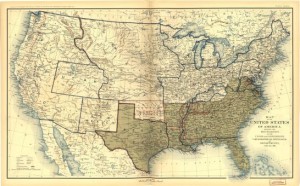 Today, the 800 African members (most of whom are slaves) of the First Baptist Church of Charlottesville (Virginia), in the wake of the recent enactment of U.S. President Abraham Lincoln‘s Emancipation Proclamation, politely make a request to white leaders of the Southern Baptist congregation: may they be allowed to form their own congregation?
Today, the 800 African members (most of whom are slaves) of the First Baptist Church of Charlottesville (Virginia), in the wake of the recent enactment of U.S. President Abraham Lincoln‘s Emancipation Proclamation, politely make a request to white leaders of the Southern Baptist congregation: may they be allowed to form their own congregation?
Well understanding the delicate nature of the situation, the black members offer assurances that they will choose a white minister as their pastor, signaling continued subservience to white church authorities.
For their part, white leaders of the congregation recognize their own precarious situation. The pace of slave escapes has intensified since the signing of the proclamation, and maintaining control over the slave population is now harder than ever. What are the real motivations of the black members? Would it be best to allow their enslaved brothers and sisters more spiritual freedom? Church leaders return to their homes tonight realizing that they must carefully consider the request and prepare an answer in time for the church’s April business meeting.
Meanwhile, to the North in Detroit, Michigan a race riot breaks out today. Many of the city’s whites have been upset since Lincoln’s call for 300,000 more soldiers the previous summer, their anger having been directed at black residents in the months ensuing. More recently, a black citizen, William Faulkner, had been arrested for allegedly raping two young white women. The trial is now underway, and today white anger comes unleashed and a mob tries to drag Faulkner from jail.
When a prison guard fires into the crowd, killing an innocent bystander, the riot begins. Some thirty homes are destroyed, two more people are killed, and some 200 of Detroit’s black citizens are left homeless. Soldiers from nearby Fort Wayne finally restore order.
Afterwards, the two alleged rape victims recant their story, and Faulker is released from prison. The Detroit race riots, however, serve to vividly illustrate the danger of racial tensions simmering in some Northern communities as the war drags ever onward.
Sources: Jean L. Cooper, A Guide to Historic Charlottesville & Albemarle County, Virginia, Charleston, S.C.: The History Press p. 131 (link); Willis F. Dunbar, George S. May, Michigan: A History of the Wolverine State, Grand Rapids: Wm. B. Eerdmans, 1995, p. 335 (link)


